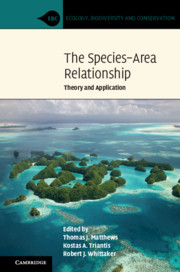Book contents
- The Species–Area Relationship
- Ecology, Biodiversity and Conservation
- The Species–Area Relationship
- Copyright page
- Contents
- Contributors
- Foreword
- Preface
- Part I Introduction and History
- Part II Diversity–Area Relationships: The Different Types and Underlying Factors
- Part III Theoretical Advances in Species–Area Relationship Research
- Part IV The Species–Area Relationship in Applied Ecology
- 13 The Identification of Biodiversity Hotspots Using the Species–Area Relationship
- 14 Using the Species–Area Relationship to Predict Extinctions Resulting from Habitat Loss
- 15 Using Network Analysis to Explore the Role of Dispersal in Producing and Maintaining Island Species–Area Relationships
- 16 Does Geometry Dominate Extinction due to Habitat Loss?
- 17 Using Relict Species–Area Relationships to Estimate the Conservation Value of Reservoir Islands to Improve Environmental Impact Assessments of Dams
- 18 An Investigation of Species–Area Relationships in Marine Systems at Large Spatial Scales
- Part V Future Directions in Species–Area Relationship Research
- Index
- References
13 - The Identification of Biodiversity Hotspots Using the Species–Area Relationship
from Part IV - The Species–Area Relationship in Applied Ecology
Published online by Cambridge University Press: 11 March 2021
- The Species–Area Relationship
- Ecology, Biodiversity and Conservation
- The Species–Area Relationship
- Copyright page
- Contents
- Contributors
- Foreword
- Preface
- Part I Introduction and History
- Part II Diversity–Area Relationships: The Different Types and Underlying Factors
- Part III Theoretical Advances in Species–Area Relationship Research
- Part IV The Species–Area Relationship in Applied Ecology
- 13 The Identification of Biodiversity Hotspots Using the Species–Area Relationship
- 14 Using the Species–Area Relationship to Predict Extinctions Resulting from Habitat Loss
- 15 Using Network Analysis to Explore the Role of Dispersal in Producing and Maintaining Island Species–Area Relationships
- 16 Does Geometry Dominate Extinction due to Habitat Loss?
- 17 Using Relict Species–Area Relationships to Estimate the Conservation Value of Reservoir Islands to Improve Environmental Impact Assessments of Dams
- 18 An Investigation of Species–Area Relationships in Marine Systems at Large Spatial Scales
- Part V Future Directions in Species–Area Relationship Research
- Index
- References
Summary
Hotspot identification is a crucial strategy for setting conservation priorities. Since both the total number of species and the number of endemic species tend to increase with area, prioritizing sites according to their overall species richness or endemic species richness can produce rankings that simply mirror the sizes of the sites. Thus, it is important to control for the dependence of species number on site area. For this reason, some authors have proposed that the species–area relationship (SAR) and/or the endemics–area relationship (EAR) should be modelled and then the sites located above the fitted curve(s) (i.e. those having positive residuals) designated as hotspots. However, (1) there may be large uncertainties about which model provides the best fit to the SARs/EARs, (2) the use of residuals may lead to sites being identified as hotspots when they only have very few species and (3) there is no guarantee that the sites selected as hotspots by the SAR really include a large fraction of the overall diversity. Thus, it is important to evaluate the ability of the hotspots designated by these procedures to really conserve total and endemic species diversity; the best strategy may in fact be to use a combination of approaches.
Keywords
- Type
- Chapter
- Information
- The Species–Area RelationshipTheory and Application, pp. 321 - 344Publisher: Cambridge University PressPrint publication year: 2021
References
- 6
- Cited by

